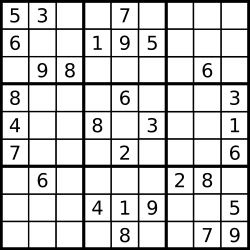Valid Sudoku
Determine if a Sudoku is valid, according to: Sudoku Puzzles - The Rules.
The Sudoku board could be partially filled, where empty cells are filled with the character ‘.‘.

A partially filled sudoku which is valid.
判断数独当前状态是否合法
class Solution
{
public:
bool isValidSudoku(vector<vector<char>>& board)
{
int col[10][10],row[10][10],box[10][10];
int i,j,x,a;
memset(col,0,sizeof(col));
memset(row,0,sizeof(row));
memset(box,0,sizeof(box));
for (i=0;i<9;i++)
for (j=0;j<9;j++)
if (board[i][j]!='.')
{
x=board[i][j]-'0';
a=i/3*3+j/3;
if (row[i][x]==1 || col[j][x]==1 || box[a][x]==1) return false;
else row[i][x]=col[j][x]=box[a][x]=1;
}
return true;
}
};Write a program to solve a Sudoku puzzle by filling the empty cells.
Empty cells are indicated by the character ‘.‘.
You may assume that there will be only one unique solution.

A sudoku puzzle...

...and its solution numbers marked in red.
DFS解数独,保证唯一解class Solution
{
int col[10][10],row[10][10],box[10][10];
public:
void solveSudoku(vector<vector<char> >& board)
{
memset(col,0,sizeof(col));
memset(row,0,sizeof(row));
memset(box,0,sizeof(box));
for (int i=0;i<9;i++)
for (int j=0;j<9;j++)
if (board[i][j]!='.')
{
col[j][board[i][j]-'0']=1;
row[i][board[i][j]-'0']=1;
box[i/3*3+j/3][board[i][j]-'0']=1;
}
dfs(board,0);
}
bool dfs(vector<vector<char> > & board,int key)
{
int i,j;
if (key==81) return true;
int x=key/9;
int y=key%9;
if (board[x][y]!='.')
return dfs(board,key+1);
else
{
int a=x/3*3+y/3;
for (int i=1;i<=9;i++)
if (col[y][i]==0 && row[x][i]==0 && box[a][i]==0)
{
col[y][i]=row[x][i]=box[a][i]=1;
board[x][y]=i+'0';
if (dfs(board,key+1)) return true;
col[y][i]=row[x][i]=box[a][i]=0;
board[x][y]='.';
}
}
return false;
}
};
The count-and-say sequence is the sequence of integers beginning as follows:
1, 11, 21, 1211, 111221, ...
1 is read off as "one
1" or 11.
11 is read off as "two
1s" or 21.
21 is read off as "one
2, then one 1" or 1211.
Given an integer n, generate the nth sequence.
Note: The sequence of integers will be represented as a string.
模拟过程class Solution
{
public:
string countAndSay(int n)
{
vector<int>mark[n+1];
int temp;
char ch;
mark[1].push_back(1);
string ans;
int i,sum,j;
for (i=2;i<=n;i++)
{
temp=mark[i-1][0];
sum=1;
for (j=1;j<mark[i-1].size();j++)
if (mark[i-1][j]!=temp)
{
mark[i].push_back(sum);
mark[i].push_back(temp);
temp=mark[i-1][j];
sum=1;
}
else sum++;
mark[i].push_back(sum);
mark[i].push_back(temp);
}
ans="";
for (i=0;i<mark[n].size();i++)
{
ch=mark[n][i]+'0';
ans=ans+ch;
}
return ans;
}
};Given a set of candidate numbers (C) and a target number (T), find all unique combinations in C where the candidate numbers sums to T.
The same repeated number may be chosen from C unlimited number of times.
Note:
For example, given candidate set 2,3,6,7 and target 7,
A solution set is:
[7]
[2, 2, 3]
Given a collection of candidate numbers (C) and a target number (T), find all unique combinations in C where the candidate numbers sums to T.
Each number in C may only be used once in the combination.
Note:
For example, given candidate set 10,1,2,7,6,1,5 and target 8,
A solution set is:
[1, 7]
[1, 2, 5]
[2, 6]
[1, 1, 6]
class Solution
{
vector<vector<int> >ans;
vector<int>num;
int key;
int len;
private:
void dfs(vector<int>mark,int n,int sum,int used)
{
if (sum==key)
{
ans.push_back(mark);
return ;
}
if (n==len) return ;
if (sum+num[n]>key) return ;
dfs(mark,n+1,sum,0);
if (num[n]==num[n-1] && used==0) return ;
mark.push_back(num[n]);
dfs(mark,n+1,sum+num[n],1);
mark.pop_back();
}
public:
vector<vector<int>> combinationSum2(vector<int>& candidates, int target)
{
len=candidates.size();
num=candidates;
sort(num.begin(),num.end());
key=target;
vector<int>mark;
dfs(mark,0,0,1);
return ans;
}
};
版权声明:本文为博主原创文章,未经博主允许不得转载。
原文:http://blog.csdn.net/u011932355/article/details/47790213